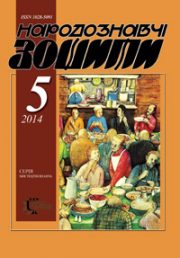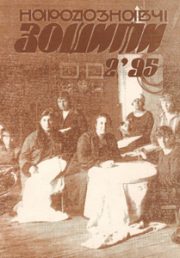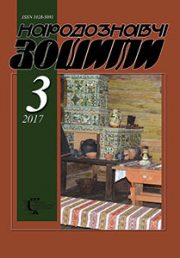The Ethnology Notebooks. 2025. № 5 (185), 1085—1096
UDK726:27-523.42-035.3](477.83-22<Кугаїв>)”2023/2025″
THE CHURCH OF EPIPHANY IN KUHAIV IN THE LIGHT OF NEW ARTIFACTS DISCOVERED DURING RESTORATION WORKS IN 2023—2025
PASHCHAK Yaroslav
- ORCID: https://orcid.org/0009-0007-6423-5449
- Postgraduate of the Department of Architecture and
- Conservation, Lviv Polytechnic National University,
- 12. Bandery str., 79013, Lviv, Ukraine,
- Contacts: e-mail: yaroslav.v.pashchak@lpnu.ua
TARAS Yaroslav
- ORCID ID: https://orcid.org/0000-0001-7241-9466
- Doctor of Historical Sciences, Professor, Institute of Ethnology
- of the National Academy of Sciences of Ukraine,
- Head of the Modern Ethnology Department,
- 15, Svobody Avenue, 79000, Lviv, Ukraine;
- Lviv Polytechnic National University,
- Department of Architecture and Conservation,
- 12, Banderу str., 79013, Lviv, Ukraine,
- Contacts: e-mail: etnomod@ukr.net
Abstract. Restoration work being carried out in Ukraine today has shown that after removing the clapboard from the walls, tops, and probing, new finds have appeared that confirm or refute previously existing information about the object under study. We have this situation with the Church of Epiphany in the village of Kuhaiv in the Lviv region, the preparatory and restoration works of which in 2023—2025 discovered many previously unknown artifacts related to its history and places in the sacred architecture of Ukraine. The discovered finds require clarification and development of a general methodology for the restoration of churches that have suffered extensive destruction. The object of the research is the wooden church of Epiphany in the village of Kuhaiv, Lviv region. The purpose of the exploration is to trace the entire aspect of the preparatory and restoration works and to identify artifacts in them that confirm or refute previously known information about the church of Epiphany. The subject is the architectural and constructive solutions of the walls, tops, gable roofs, slits and decorative solutions that testify the place and significance of this church in the genesis of the sacred architecture of Ukraine. The source base of the investigation is field research of the monument, collected by the authors during the preparatory and restoration works in 2023—2025, and restoration projects: «Church Restoration Project 1984» (architect S. Tsymbalyuk), «Church Restoration Project 2021» (architect M. Hayda).
The tops above the babinets, nave, and altar were examined in detail, and it was determined what wood species the walls and tops were made of. Decorative elements were considered as a separate issue. The reasons for the transformation of the three-domed church into a single-domed one in 1874 were clarified.
Based on the discovered artifacts, it has been confirmed that the church is unchanging repeating pattern of Ukrainian sacred building, which originated in the 14th century, characteristic of the sacred architecture of the 15th—17th centuries.
Keywords: Galicia, Kuhaiv, the church of Epiphany, sacred architecture, restoration, conservation.
Received 15.09.2025
REFERENCES
- Zharikov, N.L. (Ed.) (1985). Monuments of urban planning and architecture of the Ukrainian SSR (Vol. 3). Kyiv: Budivelnуk [in Russian].
- Slobodian, V. (1996). Catalogue of existing wooden churches of Ukraine and Ukrainian ethnic lands. Bulletin of the Institute «Ukrzakhidproekrestavratsiya», 4, 74—159 [in Ukrainian].
- Krushynska, O. (2007). Forty-four wooden temples of Lviv region. Kyiv: Grani-T [in Ukrainian].
- Ziatyk, B. (2014). Iconostasis of the Church of Epiphany in the village of Kuhayiv, Lviv region. Problem of conservation and research. The Ethnology Notebooks, 6, 1514—1520 [in Ukrainian].
- Ziatyk, B. (2013—2014). Iconography of the iconostasis of the Church of Epiphany in the village of Kuhayiv, Lviv region. Rukotvir, 3, 235—245 [in Ukrainian].
- Hayda, M. (2012). Architectural monument of the 17th century — the ensemble of the Church of Epiphany in the village of Kuhayiv, Pustomyty district, Lviv region. Materials of research and project of restoration of the object. Phenomenon of a wooden church. Collection of articles of the international scientific conference. Lviv: Rastr-7 [In Ukrainian].
- Hayda, M. (2021). The project of restoration of the church building. Explanatory note (Vol. 5). Lviv [In Ukrainian].
- Blazejowskyj, D. (2004). Historical Shematism of the Archeparchy of Lviv (1832—1944) (Vol. I: Administration and Parishes). Kyiv: Publishing House KM Academia [in Ukrainian].
- Dragan, M. (1937). Ukrainian wooden churches. Genesis and development of forms: in 2 parts (Part 1). Lviv [in Ukrainian].
- Kusal, P., & Krycinski, S. (2020). Churches of Eastern Galicia. Rzeszow: Libra [in Polish].
- Slobodyan, V. (2020). Ukrainian wooden churches in the drawings of Anton Varyvoda. Lviv: UCU Publishing House [in Ukrainian].







